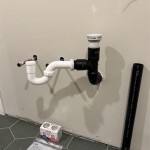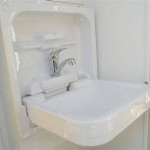Public Bathroom Sink Water Pipe Leaking From Wall: Causes, Solutions, and Prevention
A leaking water pipe in a public bathroom sink is a common problem that can lead to water damage, mold growth, increased water bills, and potential safety hazards. Identifying the source of the leak and addressing it promptly is crucial for preventing further damage and maintaining a clean and functional bathroom environment. This article will explore the common reasons behind a leaking water pipe in a public bathroom sink, provide potential solutions, and offer preventative measures to avoid future occurrences.
Common Causes of a Leaking Water Pipe in a Public Bathroom Sink
There are several reasons why a water pipe might leak from the wall behind a public bathroom sink. Understanding the potential causes is essential for identifying the specific issue and choosing the right approach to solve it.
1. Corroded or Damaged Pipes: Over time, water pipes can corrode or become damaged due to factors such as age, mineral deposits, fluctuating water pressure, or improper installation. This can lead to pinhole leaks or cracks, causing water to seep out. 2. Loose Connections: Water pipes are connected using various fittings, such as elbows, unions, and couplings. If these connections become loose over time, they can start leaking. Movement in the wall, vibrations from nearby plumbing fixtures, or even simple wear and tear can contribute to loose connections. 3. Burst or Cracked Pipes: In extreme cases, a water pipe can burst or crack due to freezing temperatures, excessive water pressure, or physical impact. This can lead to a significant water leak, quickly causing severe damage. 4. Faulty Valves: The shut-off valve controlling the water supply to the sink may malfunction or become worn out. This can result in leaks from the valve itself or from the pipe connected to it. 5. Improper Installation: If the water pipes were not installed correctly in the first place, there is a higher risk of leaks developing down the line.
It is important to note that these causes are not mutually exclusive and in some cases, multiple factors may contribute to the leak. For example, corrosion can weaken a pipe, making it more susceptible to cracking or bursting under pressure.
Solutions for a Leaking Water Pipe in a Public Bathroom Sink
The best approach to fixing a leaking water pipe depends on the specific cause and the extent of the damage. Here are some common solutions:
1. Repair or Replace Damaged Pipes: If the leak is caused by corrosion or damage to the pipes, they will need to be repaired or replaced. This may involve cutting out a section of the existing pipe and inserting a new piece or replacing the entire pipe run. 2. Tighten Loose Connections: If the leak is due to loose connections, tightening the fittings may be enough to stop the leak. In some cases, it may be necessary to replace the fittings entirely. 3. Replace Faulty Valves: If the shut-off valve is malfunctioning, it should be replaced with a new one. 4. Address Burst or Cracked Pipes: Burst or cracked pipes require immediate attention and professional assistance. A plumber will need to assess the damage, isolate the leak, and then repair or replace the affected section of the pipe. 5. Re-installation: In situations where the leak is attributed to improper initial installation, proper re-installation by a qualified professional is required.
Preventing Future Leaks
While a leaking water pipe in a public bathroom sink can be a significant issue, it is possible to take steps to prevent future occurrences. Here are some preventative measures:
1. Regular Inspections: Conducting regular inspections of the plumbing system, including the water pipes, can help detect potential problems early on. This allows for timely repairs before they escalate into major leaks. 2. Maintain Water Pressure: High water pressure can put unnecessary stress on pipes and connections, increasing the risk of leaks. Maintaining appropriate water pressure through a pressure-regulating valve can help mitigate this risk. 3. Protect Pipes from Freezing: In cold climates, it is essential to protect water pipes from freezing, as frozen pipes can expand and burst. Insulation, heat tracing, or allowing a small trickle of water to flow through the pipes can help prevent this. 4. Consider Pipe Material: When replacing or installing new plumbing, opting for durable and corrosion-resistant materials, such as copper or PEX, can reduce the likelihood of leaks. 5. Professional Installation: Always engage a qualified plumber for installation and repair work to ensure proper connections, leak-free installations, and minimize the risk of future problems.
Addressing a leaking water pipe in a public bathroom sink requires timely intervention to prevent damage and ensure a safe and functional restroom environment. Understanding the common causes, implementing appropriate solutions, and taking preventative measures can help minimize the risk of future leaks and maintain the integrity of the plumbing system.

Bathroom Leak Top 5 Causes Waterleak Co

How To Handle Leaking Pipes Under The Bathroom Sink Aggressive Mechanical

How Much Does Bathroom Leak Repair Cost

How To Patch And Fix A Leaking Waste Pipe Build Plumb
Find And Repair Plumbing Leaks Diy Family Handyman

Toilet Pipe Leak Prima Seal Waterproofing Singapore

Frequently Asked Questions About Water Leak Detection Repair Barker Sons Plumbing

Fixing Common Leaks Around The Home

How To Repair A Toilet Water Supply Line Leak Step By

How To Find A Water Leak 10 Ways Detect Plumbing Problems Bob Vila
Related Posts







